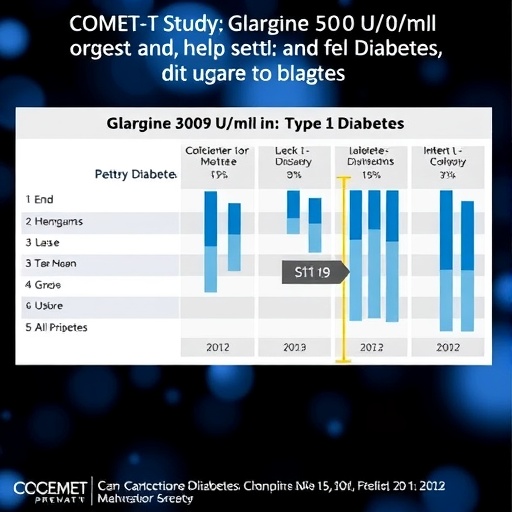Recent advancements in the management of diabetes have brought forth a significant change in approaches to insulin therapy, particularly for patients with Type 1 diabetes. In a recent publication titled “Correction to: Safety and Effectiveness of Glargine 300 U/ml After Switching from Basal Insulins in Patients with Type 1 Diabetes: COMET-T Study,” researchers, including Gölz, Mader, and Bilz, delve into the implications of switching diabetic patients from traditional basal insulins to a newer formulation of glargine. Their findings contribute critical insights that could reshape clinical practices and enhance patient outcomes in diabetes management.
The COMET-T study serves as a cornerstone for understanding the effects of glargine 300 U/ml, a long-acting insulin, that has gained traction among healthcare professionals for its potential advantages over older insulin options. The study was meticulously designed to evaluate both the safety and efficacy of glargine in patients transitioning from different basal insulin therapies. The implications of such a switch are profound, addressing both glycemic control and the potential reduction of adverse side effects associated with the previous therapies. As diabetes remains a pervasive health challenge, the results of this research could have wide-reaching benefits.
A key aspect of the investigation revolves around assessing the safety profile of the newer glargine formulation. Safety concerns regarding insulin therapies often arise from potential hypoglycemic episodes and other complications that can arise with the use of traditional insulins. The authors rigorously examined adverse events during the study duration, providing critical data that highlights the relative safety of glargine in comparison to its predecessors. This data brings reassurance to both practitioners and patients alike when considering a transition to this innovative insulin therapy.
In addition to safety, the COMET-T study also explores the effectiveness of glargine 300 U/ml in achieving optimal glycemic control. With a focus on metrics such as HbA1c levels and fasting plasma glucose, the researchers provided quantitative evidence showcasing the efficacy of glargine in maintaining stable blood glucose levels within the target range. This aspect of the study is crucial, as achieving well-controlled blood glucose levels is paramount in preventing long-term complications associated with diabetes, including cardiovascular diseases, neuropathy, and nephropathy.
Another noteworthy observation derived from the study is the impact of glargine transition on patients’ quality of life. Participants reported notable improvements in their daily lives, underscoring the psychological and emotional benefits that can accompany improved glycemic control. This includes reduced anxiety surrounding insulin management and the ability to engage more fully in daily activities without the fear of hypoglycemia. Enhancements in quality of life are essential to comprehensive diabetes care, emphasizing the holistic approach needed when treating such a complex condition.
The transition to glargine 300 U/ml was also assessed for feasibility and acceptability among patients. Feedback from those who switched medications indicated a high degree of satisfaction with their treatment regimen. This is promising news for healthcare providers, facilitating easier implementation of insulin changes and promoting adherence to treatment plans that ultimately benefit patient health. This positive reception further underscores the potential for glargine to become a mainstream choice for basal insulin therapy.
Of utmost importance in the study is the demographic diversity among participants, which included a wide range of ages, backgrounds, and prior treatment experiences. This inclusivity enhances the validity of the study findings, making strides toward personalized medicine in diabetes care. The results speak to the ability of glargine 300 U/ml to meet the needs of a varied patient population, emphasizing its adaptability in different clinical scenarios.
As diabetes continues to evolve as a critical public health issue, the findings from the COMET-T study contribute significantly to the growing body of literature dedicated to optimizing diabetes management. The integration of newer insulin formulations such as glargine 300 U/ml can potentially revolutionize treatment paradigms, making it essential for healthcare providers to remain informed about advancements in diabetes therapy. The posterior findings may also stimulate further research into long-acting insulin alternatives, creating a wave of innovation in diabetic care.
Moreover, the publication of these results comes at a crucial juncture, as increasing numbers of individuals are being diagnosed with diabetes globally. The global burden of diabetes requires ongoing efforts to refine treatment modalities and improve patient care. The insights presented in the COMET-T study are a vital piece of this complex puzzle, paving the pathway toward enhanced management strategies tailored to individual patient needs.
In sum, the safety and effectiveness of glargine 300 U/ml, as depicted in the COMET-T study, showcase a promising shift in the treatment landscape for Type 1 diabetes. With strong data supporting its safety, efficacy, and overall patient satisfaction, glargine stands to play a pivotal role in reimagining how diabetes is managed in clinical settings. As more healthcare professionals become acquainted with these findings, a paradigm shift could emerge, enabling a brighter future for those navigating the challenges of diabetes.
This groundbreaking research not only emphasizes the necessity for continual advancements in diabetes care but also highlights the importance of patient-centered approaches in therapeutic choices. Harnessing the potential of glargine, alongside ongoing education and research, can foster an environment where better health outcomes are achievable, and ultimately, represent a significant leap forward in diabetes management.
The findings and implications drawn from the COMET-T study reinforce the need for an evidence-based approach to therapeutic choices in diabetes management. As the medical field continues to embrace innovation, insights from such studies will shape future practices, guiding healthcare professionals toward better outcomes for their patients.
Subject of Research: Safety and Effectiveness of Glargine 300 U/ml After Switching from Basal Insulins in Patients with Type 1 Diabetes.
Article Title: Correction to: Safety and Effectiveness of Glargine 300 U/ml After Switching from Basal Insulins in Patients with Type 1 Diabetes: COMET-T Study.
Article References:
Gölz, S., Mader, J.K., Bilz, S. et al. Correction to: Safety and Effectiveness of Glargine 300 U/ml After Switching from Basal Insulins in Patients with Type 1 Diabetes: COMET-T Study.
Diabetes Ther (2025). https://doi.org/10.1007/s13300-025-01771-2
Image Credits: AI Generated
DOI:
Keywords: Glargine, Type 1 Diabetes, Insulin Therapy, COMET-T Study, Diabetes Management, Safety and Efficacy.
Tags: COMET-T study findingsdiabetes clinical practicesGlargine 300 U/ml insulin therapyglycemic control in diabetesinsulin formulation implicationsinsulin therapy advancementslong-acting insulin optionspatient outcomes in diabetesreducing adverse side effects in diabetessafety and efficacy of glarginetransitioning from basal insulinsType 1 diabetes management





